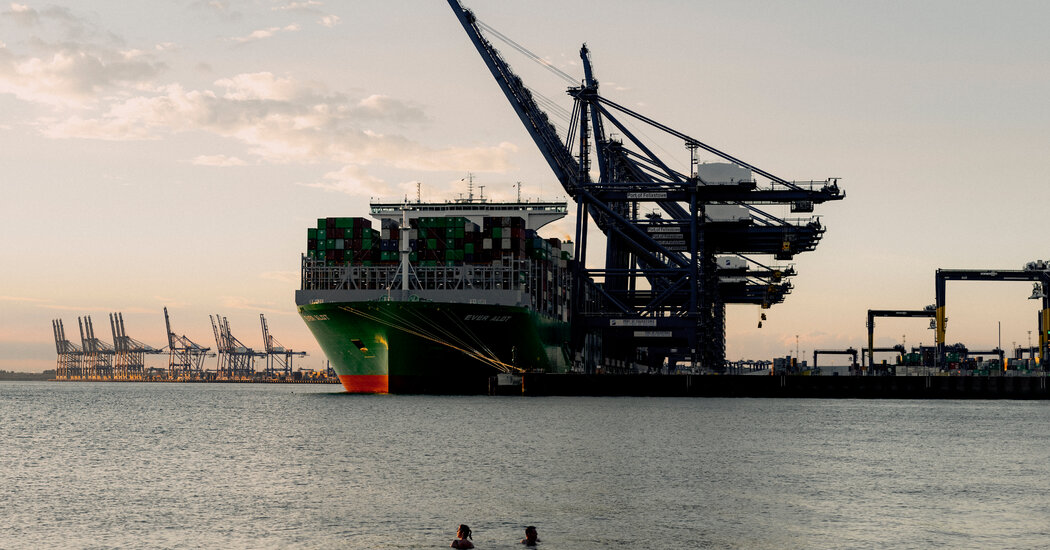It didn’t make many headlines, but last week, at a meeting of the International Maritime Organization, something potentially world-changing happened.
The United Nations agency, which regulates the shipping industry, essentially committed to creating the world’s first global carbon price.
“I’m very confident that there is going to be an economic pricing mechanism by this time next year,” Arsenio Dominguez, the Secretary General of the maritime organization, said. “What form it is going to have and what the name is going to be, I don’t know.”
The proposal would require shipping companies to pay a fee for every ton of carbon they emit by burning fuel. In other words, it’s a tax.
That could raise a significant amount of money and lead to sweeping changes in the shipping industry. It would also be a first step toward the lofty goal of a tax not limited to a particular country, but a global one. (Some 70 countries and states around the world have put a price on carbon, either through taxes or trading mechanisms.) Many activists and economists have argued that putting a price on carbon is crucial to addressing the collective threat of climate change, because it can both deter pollution and fund a cleaner, more resilient economy.
A big pot of money
The world’s attention turned to the shipping industry this week when the Dali, a massive container ship, lost power and crashed into the Key Bridge in Baltimore. But there are at least 50,000 cargo ships like the Dali, constantly on the move, transporting the vast majority of the world’s goods.
Shipping accounts for roughly 3 percent of global greenhouse gas emissions, slightly more than aviation. Taxing its carbon emissions would very likely raise tens of billions of dollars a year for climate policy.
By comparison, developed nations have donated $9 billion to the Green Climate Fund, a U.N. program meant to help developing countries tackle climate change, but activist groups say this is far less than what is needed.
“We are talking about something that can really improve the landscape of climate finance,” said Dominik Englert, an economist who researches green shipping at the World Bank. “Given the volumes that we see and given the needs that we see, we think that it can go beyond shipping.”
There is still a lot to work out. But moving forward may be easier than with global climate negotiations that require unanimous support. Decisions at the I.M.O. are made by a simple majority of the member countries.
What countries agreed to do
The maritime organization said it was simply living up to its pledge, made last year, to decarbonize the entire shipping industry by 2050. Its member countries have agreed that they need to start charging the shipping industry for emissions of heat-trapping gases in 2027.
Last week, in a consensus vote, I.M.O. member nations detailed the decisions that still need to be made about pricing carbon. How would a price be calculated? Would it be a flat fee or part of a trading mechanism between companies? Who would collect the money and distribute it? And which fuels are considered low-carbon?
Countries are looking at seven different proposals, in which prices range from $20 to $250 per ton of carbon emissions, according to the maritime organization. They hope to decide on all that by next year.
“It’s been an extremely hard process to get where we are now,” said Albon Ishoda, the Marshall Islands’ negotiator, who has proposed a tax of $150 per ton of carbon emitted.
What the impact could be
How would the carbon tax proceeds be distributed? Englert and his colleagues from the World Bank suggested in a study that countries should use the money to decarbonize the shipping industry, invest in efficiency measures that could reduce shipping costs for poorer countries and deployed for broader climate action.
Charging for ships’ carbon emissions could have an impact on basically everything we buy. Coffee from Colombia, T-shirts from Vietnam and mobile phones from China all get to consumers across the world by ship.
Roel Hoenders, the I.M.O.’s head of climate action, warned that small countries could end up paying steeper prices for basic goods. Countries that built their economies around shipping commodities could lose significant revenue, because shipping accounts for such a large share of the price of their exports.
Assessing the impact each measure would have “is quite an important part of the work, particularly for developing countries,” he said. “An increase in carbon price may have an impact on their competitiveness at a global scale.”
Lessons for the rest of the world
Some of the shipping industry’s biggest players have come around to the need for cleaner fuels and are looking for ways to develop them more quickly. Maersk, the second-largest container shipping company, has already invested billions in its decarbonization efforts.
“Surprisingly for me, the industry has been perhaps more progressive in trying to put forward a target,” Ishoda said. “Many in the industry know that fossil fuels are finite. We have seen a lot more — I wouldn’t say progress, I wouldn’t call it that — but an openness to the idea of ways to raise revenues to decarbonize the shipping sector.”
Many of the world’s biggest shipping companies are pushing for a more ambitious carbon price, because that would mean they wouldn’t need to pay for the same tax in Europe. Companies ideally want to avoid paying carbon taxes in multiple jurisdictions, which would result in a lot of complex and expensive accounting.
There are a lot of difficult compromises ahead. Still, Englert said he hoped the shipping industry’s experience with pricing carbon would send a signal to the world about how powerful such a policy can be.
When done right, carbon pricing “is the most cost effective and the most straightforward policy that provides the widest range of flexibility to all economic stakeholders,” he said. “You can basically help the planet, help the climate and at the same time use the revenue to foster development.”
The tension between America’s climate goals and its rift with China
The Biden administration is trying to walk a delicate tightrope: Encourage the green energy transition while also protecting U.S. companies from heavily subsidized Chinese competitors.
U.S. officials plan to tell their counterparts in Beijing they think that artificially cheap Chinese solar panels, electric vehicles and lithium-ion batteries are distorting global markets, my colleague Alan Rappeport reports.
“China’s overcapacity distorts global prices and production patterns and hurts American firms and workers, as well as firms and workers around the world,” Janet Yellen, the U.S. Treasury secretary, said in a speech yesterday.
Yellen is expected to make her second trip to China in the coming weeks. The South China Morning Post reported that she will visit Guangzhou and Beijing in early April.
Subsidies can cut both ways. Biden’s Inflation Reduction Act included hundreds of billions in tax credits and subsidies for low-emission forms of energy production. Electric vehicles and other technologies that contain certain components made in China — and also Russia, North Korea and Iran — are not eligible for U.S. tax credits.
China isn’t standing idly by. It filed a complaint in the World Trade Organization against U.S. subsidies for electric vehicles.
Meanwhile, Tesla, which has done more than almost any other country to drive the transition to electric cars, is experiencing its own headwinds in China.
Elon Musk, the company’s chief executive, initially seemed to have the upper hand in his relationship with Beijing. But Tesla is now increasingly losing its edge over Chinese competitors in the very market it helped to create, my colleagues Mara Hvistendahl, Jack Ewing and John Liu reported.
In January, Musk issued a warning: unless the Chinese auto brands were blocked by trade barriers, they would “pretty much demolish most other car companies in the world.” — Manuela Andreoni

